Corporate Finance Report: Valuation Analysis of Tiger Airways
VerifiedAdded on 2020/05/11
|6
|1498
|60
Report
AI Summary
This report provides a comprehensive valuation analysis of Tiger Airways, a low-cost carrier, focusing on its financial performance and acquisition by SIA. It examines the company's financial statements from 2012 to 2015, highlighting the losses incurred and the subsequent acquisition by SIA, which led to its delisting. The report employs both relative and intrinsic valuation methods to determine the share price, considering competitors like AirAsia and Jetblue Airways. It explores potential alternatives for Tigerair, including allowing SIA to acquire all shares or selling to a third party. Furthermore, the report evaluates the concept of synergy in the context of the acquisition, considering the interests of major shareholder SIA and minority shareholder Hillhouse Capital. It concludes with a recommendation for Hillhouse Capital to sell their remaining shares to SIA at the offered price of $0.45, based on the valuation analysis.
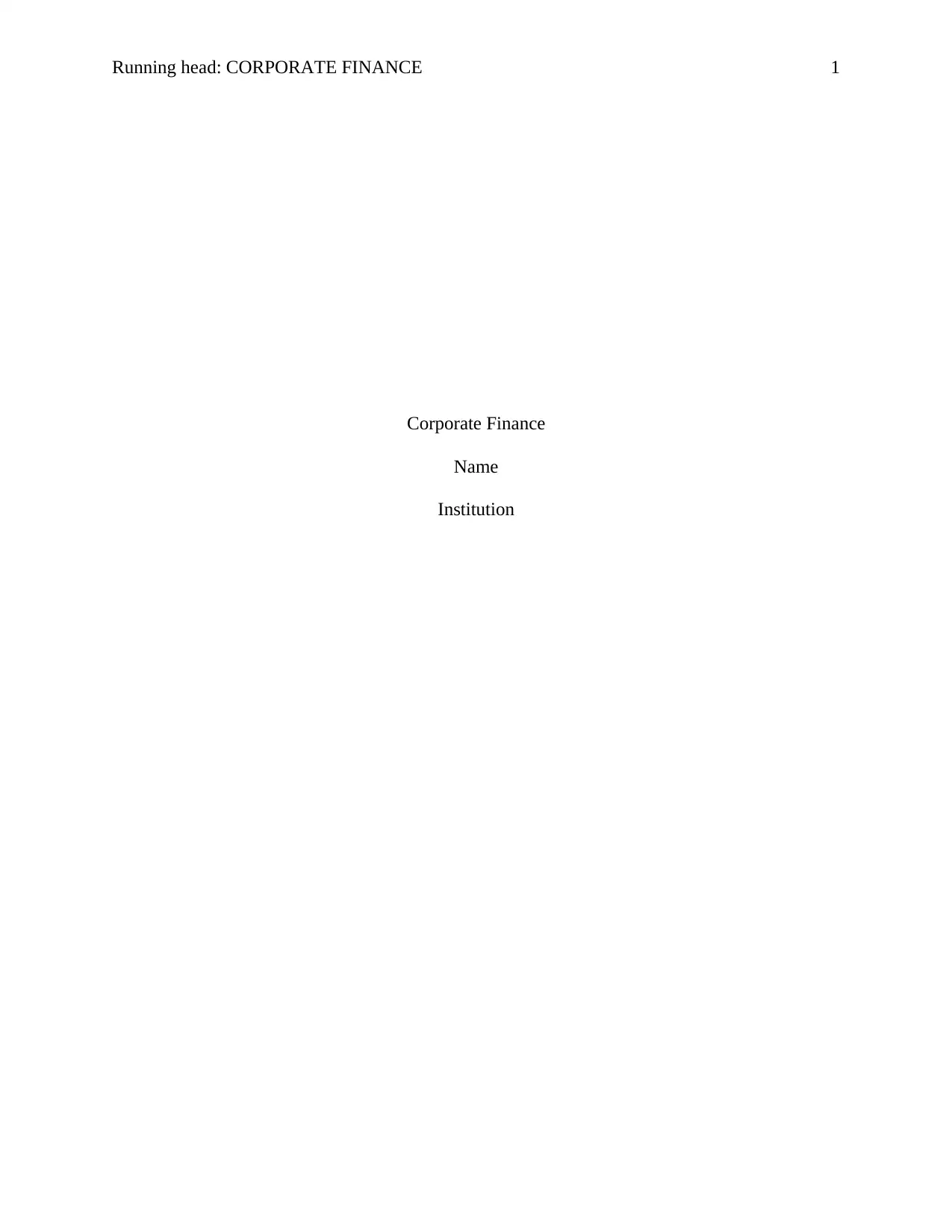
Running head: CORPORATE FINANCE 1
Corporate Finance
Name
Institution
Corporate Finance
Name
Institution
Paraphrase This Document
Need a fresh take? Get an instant paraphrase of this document with our AI Paraphraser
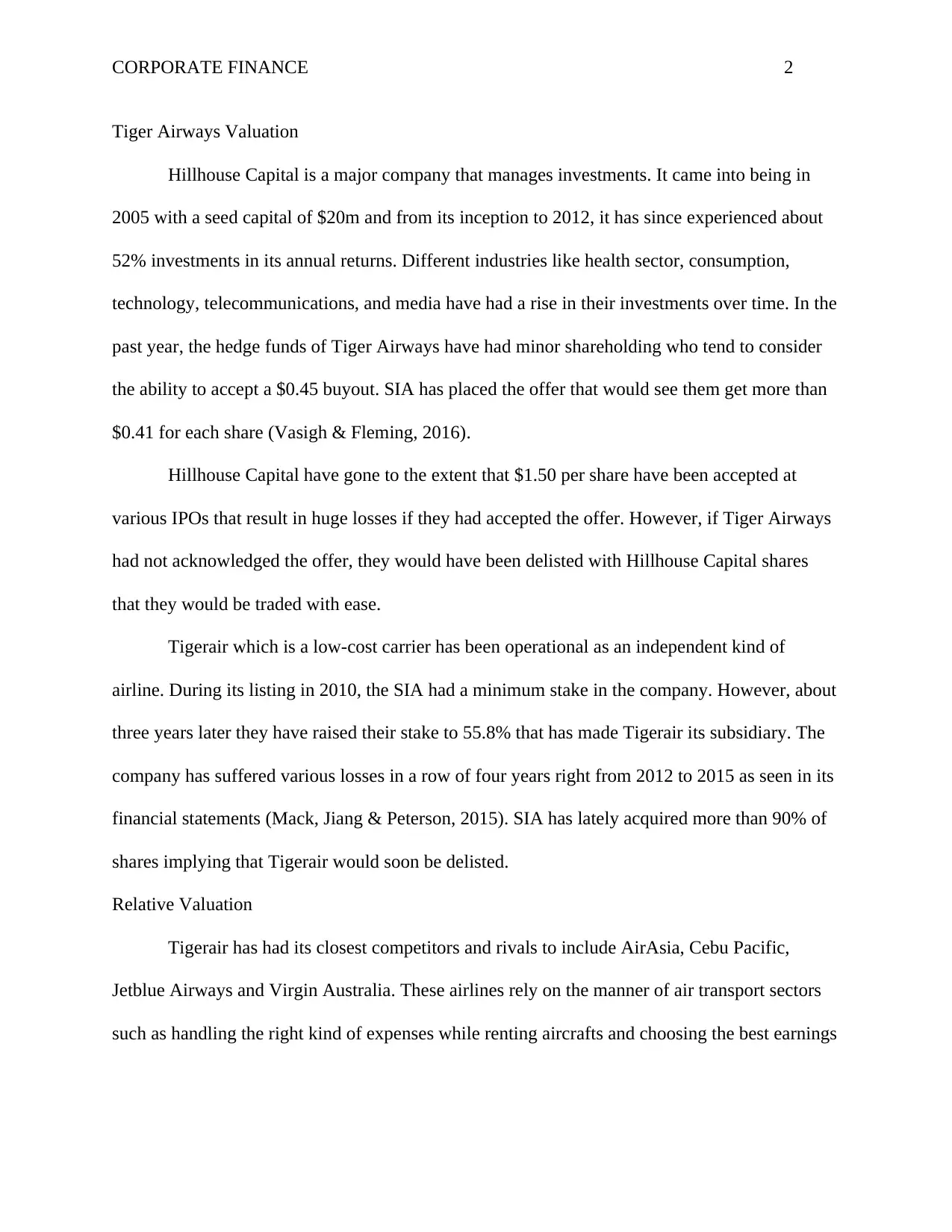
CORPORATE FINANCE 2
Tiger Airways Valuation
Hillhouse Capital is a major company that manages investments. It came into being in
2005 with a seed capital of $20m and from its inception to 2012, it has since experienced about
52% investments in its annual returns. Different industries like health sector, consumption,
technology, telecommunications, and media have had a rise in their investments over time. In the
past year, the hedge funds of Tiger Airways have had minor shareholding who tend to consider
the ability to accept a $0.45 buyout. SIA has placed the offer that would see them get more than
$0.41 for each share (Vasigh & Fleming, 2016).
Hillhouse Capital have gone to the extent that $1.50 per share have been accepted at
various IPOs that result in huge losses if they had accepted the offer. However, if Tiger Airways
had not acknowledged the offer, they would have been delisted with Hillhouse Capital shares
that they would be traded with ease.
Tigerair which is a low-cost carrier has been operational as an independent kind of
airline. During its listing in 2010, the SIA had a minimum stake in the company. However, about
three years later they have raised their stake to 55.8% that has made Tigerair its subsidiary. The
company has suffered various losses in a row of four years right from 2012 to 2015 as seen in its
financial statements (Mack, Jiang & Peterson, 2015). SIA has lately acquired more than 90% of
shares implying that Tigerair would soon be delisted.
Relative Valuation
Tigerair has had its closest competitors and rivals to include AirAsia, Cebu Pacific,
Jetblue Airways and Virgin Australia. These airlines rely on the manner of air transport sectors
such as handling the right kind of expenses while renting aircrafts and choosing the best earnings
Tiger Airways Valuation
Hillhouse Capital is a major company that manages investments. It came into being in
2005 with a seed capital of $20m and from its inception to 2012, it has since experienced about
52% investments in its annual returns. Different industries like health sector, consumption,
technology, telecommunications, and media have had a rise in their investments over time. In the
past year, the hedge funds of Tiger Airways have had minor shareholding who tend to consider
the ability to accept a $0.45 buyout. SIA has placed the offer that would see them get more than
$0.41 for each share (Vasigh & Fleming, 2016).
Hillhouse Capital have gone to the extent that $1.50 per share have been accepted at
various IPOs that result in huge losses if they had accepted the offer. However, if Tiger Airways
had not acknowledged the offer, they would have been delisted with Hillhouse Capital shares
that they would be traded with ease.
Tigerair which is a low-cost carrier has been operational as an independent kind of
airline. During its listing in 2010, the SIA had a minimum stake in the company. However, about
three years later they have raised their stake to 55.8% that has made Tigerair its subsidiary. The
company has suffered various losses in a row of four years right from 2012 to 2015 as seen in its
financial statements (Mack, Jiang & Peterson, 2015). SIA has lately acquired more than 90% of
shares implying that Tigerair would soon be delisted.
Relative Valuation
Tigerair has had its closest competitors and rivals to include AirAsia, Cebu Pacific,
Jetblue Airways and Virgin Australia. These airlines rely on the manner of air transport sectors
such as handling the right kind of expenses while renting aircrafts and choosing the best earnings
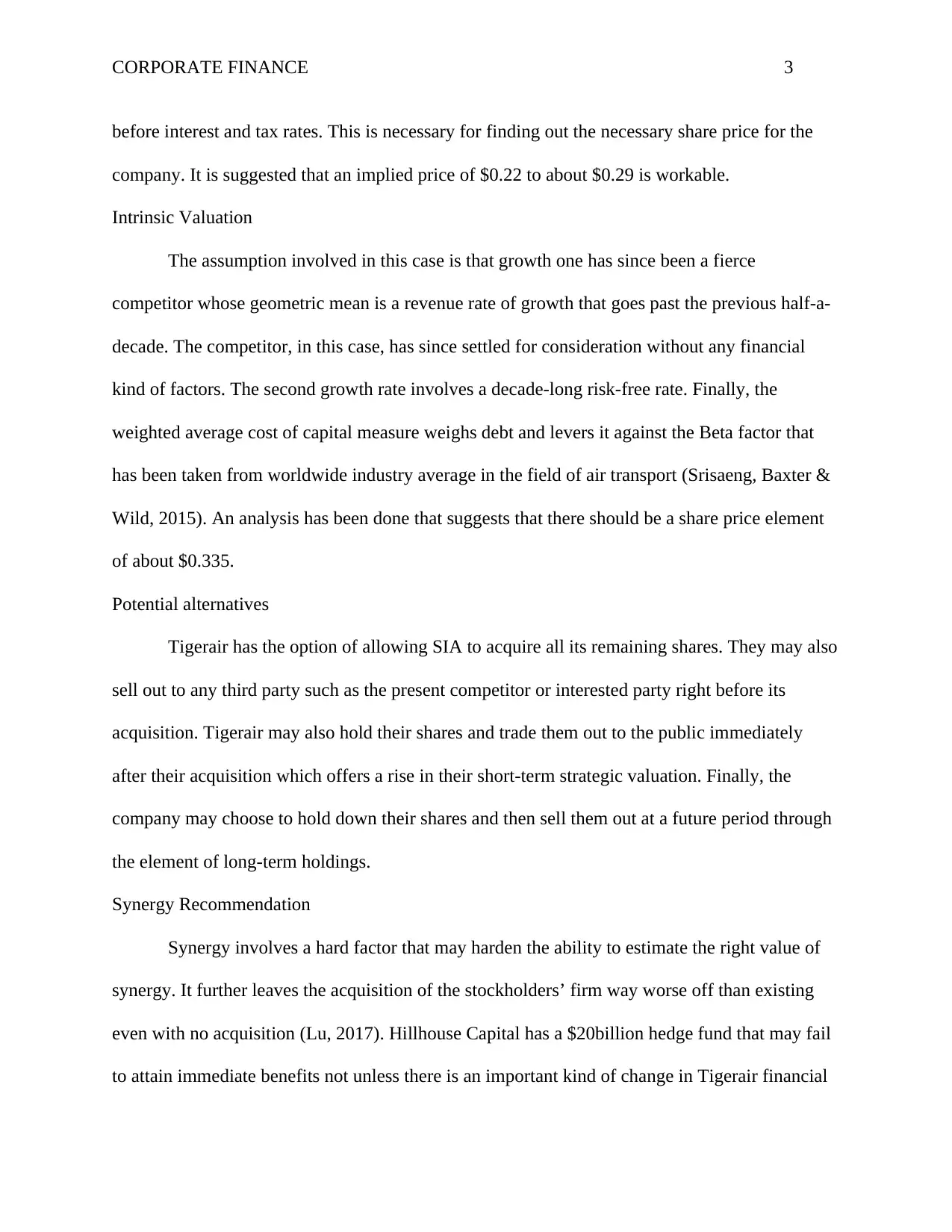
CORPORATE FINANCE 3
before interest and tax rates. This is necessary for finding out the necessary share price for the
company. It is suggested that an implied price of $0.22 to about $0.29 is workable.
Intrinsic Valuation
The assumption involved in this case is that growth one has since been a fierce
competitor whose geometric mean is a revenue rate of growth that goes past the previous half-a-
decade. The competitor, in this case, has since settled for consideration without any financial
kind of factors. The second growth rate involves a decade-long risk-free rate. Finally, the
weighted average cost of capital measure weighs debt and levers it against the Beta factor that
has been taken from worldwide industry average in the field of air transport (Srisaeng, Baxter &
Wild, 2015). An analysis has been done that suggests that there should be a share price element
of about $0.335.
Potential alternatives
Tigerair has the option of allowing SIA to acquire all its remaining shares. They may also
sell out to any third party such as the present competitor or interested party right before its
acquisition. Tigerair may also hold their shares and trade them out to the public immediately
after their acquisition which offers a rise in their short-term strategic valuation. Finally, the
company may choose to hold down their shares and then sell them out at a future period through
the element of long-term holdings.
Synergy Recommendation
Synergy involves a hard factor that may harden the ability to estimate the right value of
synergy. It further leaves the acquisition of the stockholders’ firm way worse off than existing
even with no acquisition (Lu, 2017). Hillhouse Capital has a $20billion hedge fund that may fail
to attain immediate benefits not unless there is an important kind of change in Tigerair financial
before interest and tax rates. This is necessary for finding out the necessary share price for the
company. It is suggested that an implied price of $0.22 to about $0.29 is workable.
Intrinsic Valuation
The assumption involved in this case is that growth one has since been a fierce
competitor whose geometric mean is a revenue rate of growth that goes past the previous half-a-
decade. The competitor, in this case, has since settled for consideration without any financial
kind of factors. The second growth rate involves a decade-long risk-free rate. Finally, the
weighted average cost of capital measure weighs debt and levers it against the Beta factor that
has been taken from worldwide industry average in the field of air transport (Srisaeng, Baxter &
Wild, 2015). An analysis has been done that suggests that there should be a share price element
of about $0.335.
Potential alternatives
Tigerair has the option of allowing SIA to acquire all its remaining shares. They may also
sell out to any third party such as the present competitor or interested party right before its
acquisition. Tigerair may also hold their shares and trade them out to the public immediately
after their acquisition which offers a rise in their short-term strategic valuation. Finally, the
company may choose to hold down their shares and then sell them out at a future period through
the element of long-term holdings.
Synergy Recommendation
Synergy involves a hard factor that may harden the ability to estimate the right value of
synergy. It further leaves the acquisition of the stockholders’ firm way worse off than existing
even with no acquisition (Lu, 2017). Hillhouse Capital has a $20billion hedge fund that may fail
to attain immediate benefits not unless there is an important kind of change in Tigerair financial
⊘ This is a preview!⊘
Do you want full access?
Subscribe today to unlock all pages.

Trusted by 1+ million students worldwide
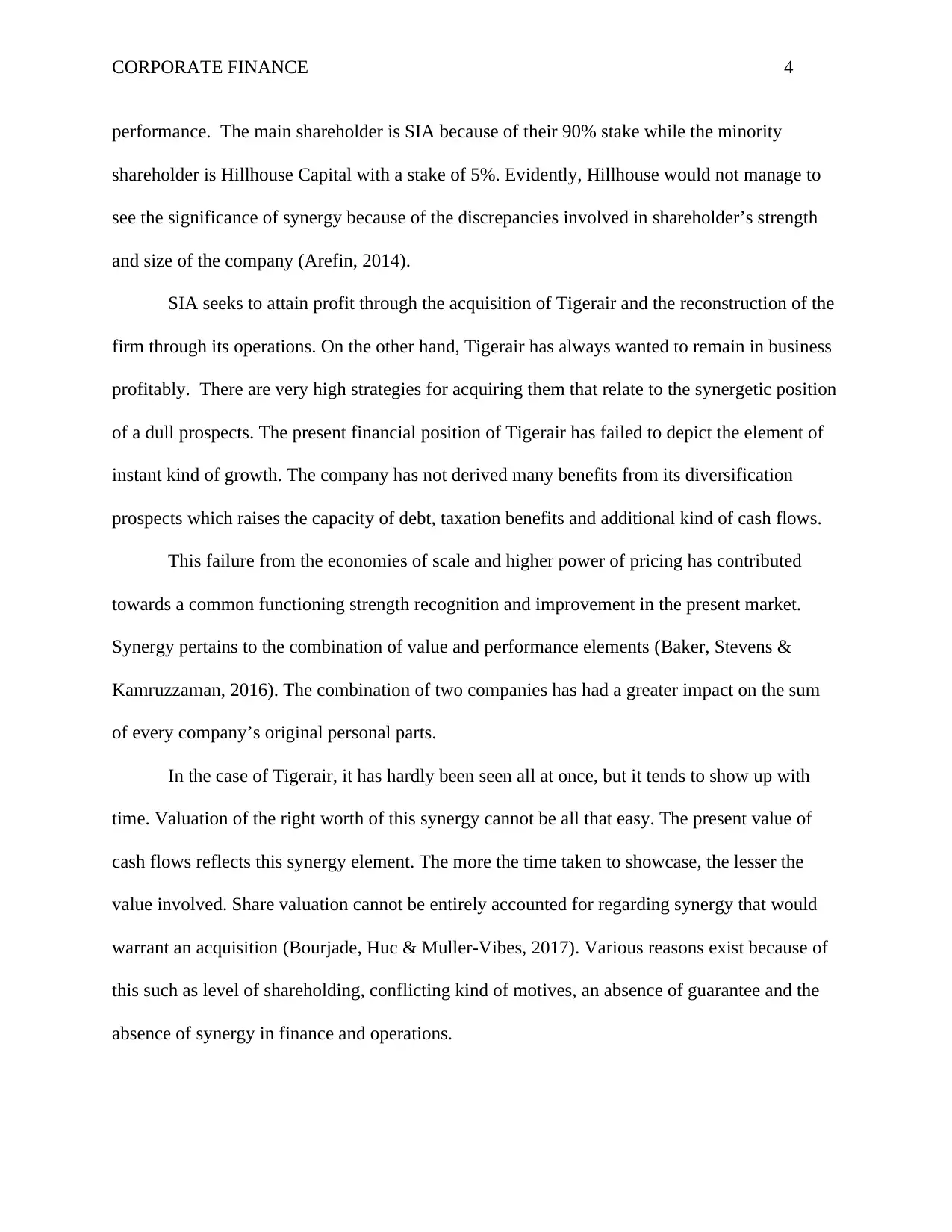
CORPORATE FINANCE 4
performance. The main shareholder is SIA because of their 90% stake while the minority
shareholder is Hillhouse Capital with a stake of 5%. Evidently, Hillhouse would not manage to
see the significance of synergy because of the discrepancies involved in shareholder’s strength
and size of the company (Arefin, 2014).
SIA seeks to attain profit through the acquisition of Tigerair and the reconstruction of the
firm through its operations. On the other hand, Tigerair has always wanted to remain in business
profitably. There are very high strategies for acquiring them that relate to the synergetic position
of a dull prospects. The present financial position of Tigerair has failed to depict the element of
instant kind of growth. The company has not derived many benefits from its diversification
prospects which raises the capacity of debt, taxation benefits and additional kind of cash flows.
This failure from the economies of scale and higher power of pricing has contributed
towards a common functioning strength recognition and improvement in the present market.
Synergy pertains to the combination of value and performance elements (Baker, Stevens &
Kamruzzaman, 2016). The combination of two companies has had a greater impact on the sum
of every company’s original personal parts.
In the case of Tigerair, it has hardly been seen all at once, but it tends to show up with
time. Valuation of the right worth of this synergy cannot be all that easy. The present value of
cash flows reflects this synergy element. The more the time taken to showcase, the lesser the
value involved. Share valuation cannot be entirely accounted for regarding synergy that would
warrant an acquisition (Bourjade, Huc & Muller-Vibes, 2017). Various reasons exist because of
this such as level of shareholding, conflicting kind of motives, an absence of guarantee and the
absence of synergy in finance and operations.
performance. The main shareholder is SIA because of their 90% stake while the minority
shareholder is Hillhouse Capital with a stake of 5%. Evidently, Hillhouse would not manage to
see the significance of synergy because of the discrepancies involved in shareholder’s strength
and size of the company (Arefin, 2014).
SIA seeks to attain profit through the acquisition of Tigerair and the reconstruction of the
firm through its operations. On the other hand, Tigerair has always wanted to remain in business
profitably. There are very high strategies for acquiring them that relate to the synergetic position
of a dull prospects. The present financial position of Tigerair has failed to depict the element of
instant kind of growth. The company has not derived many benefits from its diversification
prospects which raises the capacity of debt, taxation benefits and additional kind of cash flows.
This failure from the economies of scale and higher power of pricing has contributed
towards a common functioning strength recognition and improvement in the present market.
Synergy pertains to the combination of value and performance elements (Baker, Stevens &
Kamruzzaman, 2016). The combination of two companies has had a greater impact on the sum
of every company’s original personal parts.
In the case of Tigerair, it has hardly been seen all at once, but it tends to show up with
time. Valuation of the right worth of this synergy cannot be all that easy. The present value of
cash flows reflects this synergy element. The more the time taken to showcase, the lesser the
value involved. Share valuation cannot be entirely accounted for regarding synergy that would
warrant an acquisition (Bourjade, Huc & Muller-Vibes, 2017). Various reasons exist because of
this such as level of shareholding, conflicting kind of motives, an absence of guarantee and the
absence of synergy in finance and operations.
Paraphrase This Document
Need a fresh take? Get an instant paraphrase of this document with our AI Paraphraser
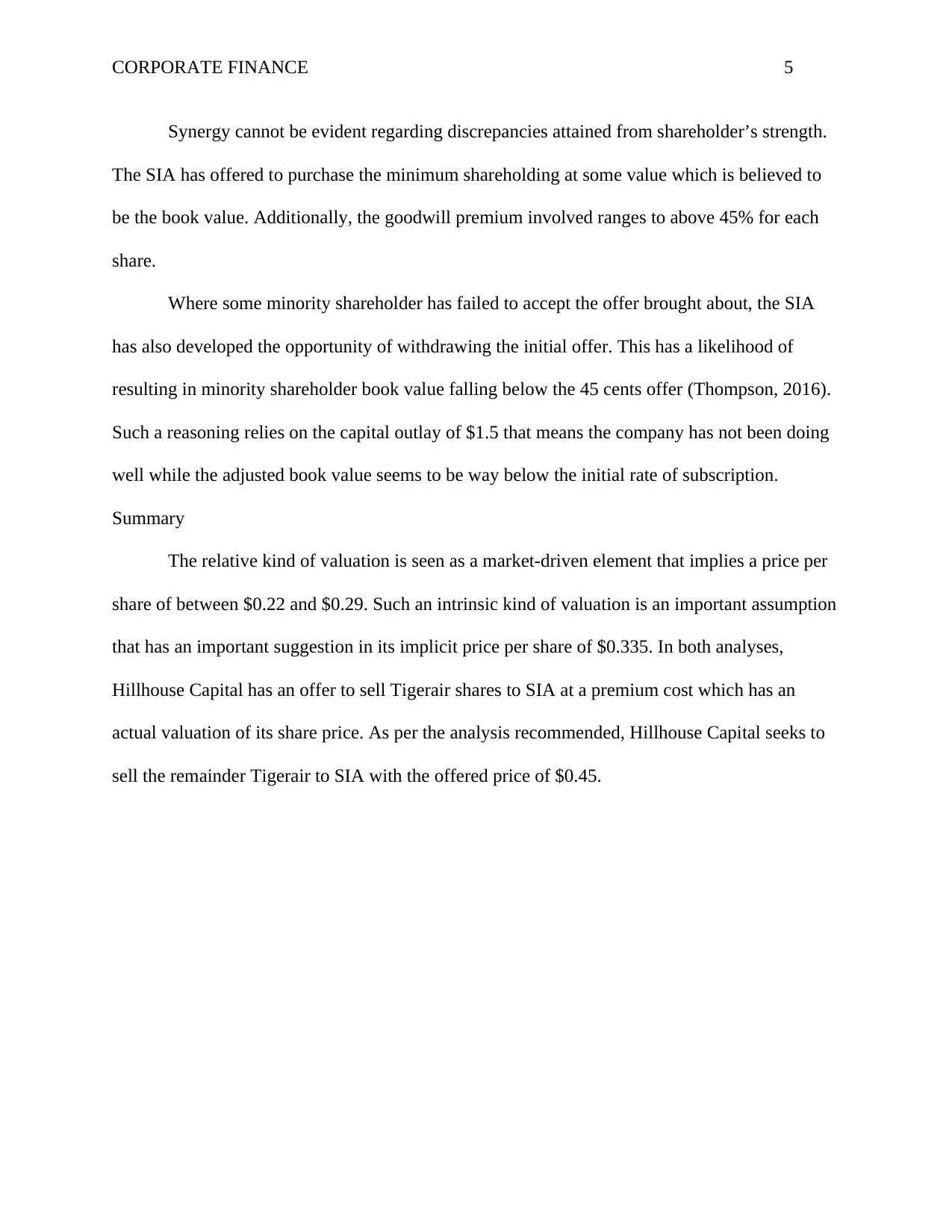
CORPORATE FINANCE 5
Synergy cannot be evident regarding discrepancies attained from shareholder’s strength.
The SIA has offered to purchase the minimum shareholding at some value which is believed to
be the book value. Additionally, the goodwill premium involved ranges to above 45% for each
share.
Where some minority shareholder has failed to accept the offer brought about, the SIA
has also developed the opportunity of withdrawing the initial offer. This has a likelihood of
resulting in minority shareholder book value falling below the 45 cents offer (Thompson, 2016).
Such a reasoning relies on the capital outlay of $1.5 that means the company has not been doing
well while the adjusted book value seems to be way below the initial rate of subscription.
Summary
The relative kind of valuation is seen as a market-driven element that implies a price per
share of between $0.22 and $0.29. Such an intrinsic kind of valuation is an important assumption
that has an important suggestion in its implicit price per share of $0.335. In both analyses,
Hillhouse Capital has an offer to sell Tigerair shares to SIA at a premium cost which has an
actual valuation of its share price. As per the analysis recommended, Hillhouse Capital seeks to
sell the remainder Tigerair to SIA with the offered price of $0.45.
Synergy cannot be evident regarding discrepancies attained from shareholder’s strength.
The SIA has offered to purchase the minimum shareholding at some value which is believed to
be the book value. Additionally, the goodwill premium involved ranges to above 45% for each
share.
Where some minority shareholder has failed to accept the offer brought about, the SIA
has also developed the opportunity of withdrawing the initial offer. This has a likelihood of
resulting in minority shareholder book value falling below the 45 cents offer (Thompson, 2016).
Such a reasoning relies on the capital outlay of $1.5 that means the company has not been doing
well while the adjusted book value seems to be way below the initial rate of subscription.
Summary
The relative kind of valuation is seen as a market-driven element that implies a price per
share of between $0.22 and $0.29. Such an intrinsic kind of valuation is an important assumption
that has an important suggestion in its implicit price per share of $0.335. In both analyses,
Hillhouse Capital has an offer to sell Tigerair shares to SIA at a premium cost which has an
actual valuation of its share price. As per the analysis recommended, Hillhouse Capital seeks to
sell the remainder Tigerair to SIA with the offered price of $0.45.
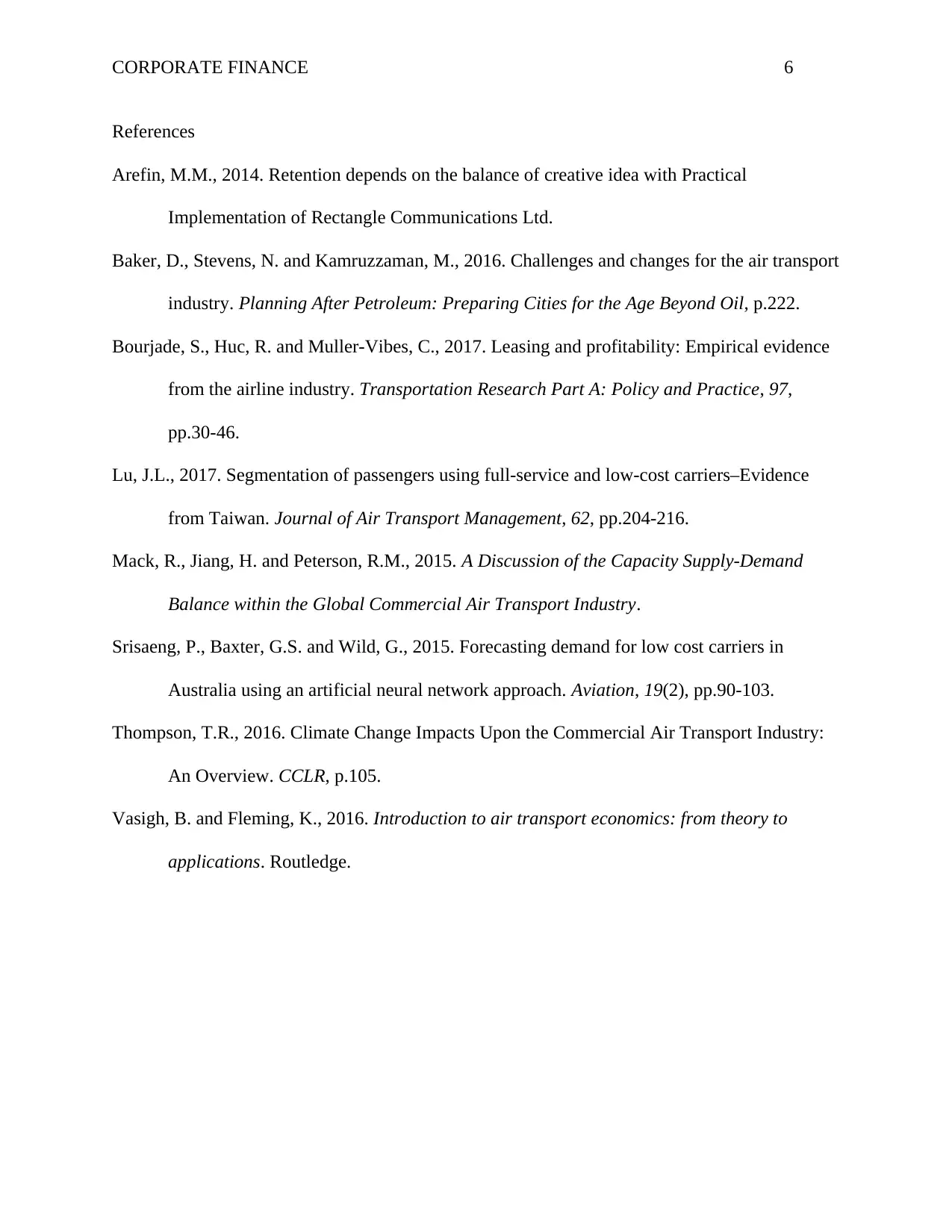
CORPORATE FINANCE 6
References
Arefin, M.M., 2014. Retention depends on the balance of creative idea with Practical
Implementation of Rectangle Communications Ltd.
Baker, D., Stevens, N. and Kamruzzaman, M., 2016. Challenges and changes for the air transport
industry. Planning After Petroleum: Preparing Cities for the Age Beyond Oil, p.222.
Bourjade, S., Huc, R. and Muller-Vibes, C., 2017. Leasing and profitability: Empirical evidence
from the airline industry. Transportation Research Part A: Policy and Practice, 97,
pp.30-46.
Lu, J.L., 2017. Segmentation of passengers using full-service and low-cost carriers–Evidence
from Taiwan. Journal of Air Transport Management, 62, pp.204-216.
Mack, R., Jiang, H. and Peterson, R.M., 2015. A Discussion of the Capacity Supply-Demand
Balance within the Global Commercial Air Transport Industry.
Srisaeng, P., Baxter, G.S. and Wild, G., 2015. Forecasting demand for low cost carriers in
Australia using an artificial neural network approach. Aviation, 19(2), pp.90-103.
Thompson, T.R., 2016. Climate Change Impacts Upon the Commercial Air Transport Industry:
An Overview. CCLR, p.105.
Vasigh, B. and Fleming, K., 2016. Introduction to air transport economics: from theory to
applications. Routledge.
References
Arefin, M.M., 2014. Retention depends on the balance of creative idea with Practical
Implementation of Rectangle Communications Ltd.
Baker, D., Stevens, N. and Kamruzzaman, M., 2016. Challenges and changes for the air transport
industry. Planning After Petroleum: Preparing Cities for the Age Beyond Oil, p.222.
Bourjade, S., Huc, R. and Muller-Vibes, C., 2017. Leasing and profitability: Empirical evidence
from the airline industry. Transportation Research Part A: Policy and Practice, 97,
pp.30-46.
Lu, J.L., 2017. Segmentation of passengers using full-service and low-cost carriers–Evidence
from Taiwan. Journal of Air Transport Management, 62, pp.204-216.
Mack, R., Jiang, H. and Peterson, R.M., 2015. A Discussion of the Capacity Supply-Demand
Balance within the Global Commercial Air Transport Industry.
Srisaeng, P., Baxter, G.S. and Wild, G., 2015. Forecasting demand for low cost carriers in
Australia using an artificial neural network approach. Aviation, 19(2), pp.90-103.
Thompson, T.R., 2016. Climate Change Impacts Upon the Commercial Air Transport Industry:
An Overview. CCLR, p.105.
Vasigh, B. and Fleming, K., 2016. Introduction to air transport economics: from theory to
applications. Routledge.
⊘ This is a preview!⊘
Do you want full access?
Subscribe today to unlock all pages.

Trusted by 1+ million students worldwide
1 out of 6
Related Documents
Your All-in-One AI-Powered Toolkit for Academic Success.
+13062052269
info@desklib.com
Available 24*7 on WhatsApp / Email
![[object Object]](/_next/static/media/star-bottom.7253800d.svg)
Unlock your academic potential
Copyright © 2020–2025 A2Z Services. All Rights Reserved. Developed and managed by ZUCOL.





